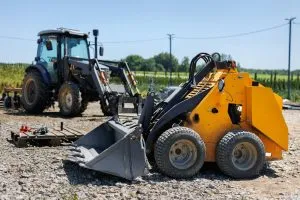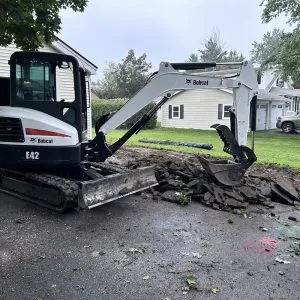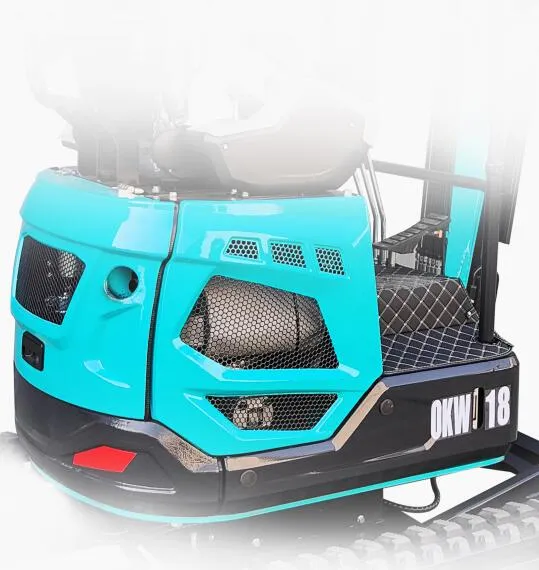Excavators are powerful, versatile machines used extensively in construction, mining, and other heavy-duty industries. Their ability to dig, lift, and move heavy materials makes them indispensable on job sites. However, like all heavy machinery, proper handling and safety measures are essential. One of the most important aspects of operating an excavator is parking it correctly. Properly parking an excavator ensures the safety of workers, prevents damage to the machine, and extends its life by minimizing wear and tear.
In this comprehensive guide, we will walk you through the correct way to park an excavator, the importance of doing so, and common mistakes to avoid.

1. Understanding the Importance of Proper Excavator Parking
Before diving into the steps of parking an excavator, it’s essential to understand why it matters. Parking an excavator improperly can lead to accidents, injuries, and unnecessary wear and tear. This includes potential rollovers, accidental damage to other machinery, or malfunctioning when restarting the machine.
Here are some reasons why proper excavator parking is crucial:
- Safety: A wrongly parked excavator can roll or move unexpectedly, causing serious harm to workers and surrounding equipment.
- Equipment Longevity: Proper parking helps maintain the integrity of the machine’s hydraulics, components, and overall structure.
- Environmental Protection: Correctly parking ensures that the excavator does not damage the surrounding environment or create soil erosion issues.
2. Parking an Excavator on Flat, Stable Ground
The first rule when parking an excavator is to always find flat and stable ground. The reason for this is to prevent any chance of the excavator tipping over. Uneven or unstable surfaces increase the risk of the machine shifting position, which could be disastrous.
- Choose a Level Surface: Always park on a flat surface to ensure stability. If you’re working on a slope, find the most level area possible or take steps to create a level parking area.
- Check Ground Stability: The ground must be firm enough to support the excavator’s weight. Avoid parking on soft soil, loose gravel, or any area that may give way under the machine’s load.

3. Lowering the Boom and Bucket
One of the most important aspects of safely parking an excavator is correctly positioning the boom and bucket. Leaving the boom raised can create instability and could also lead to hydraulic damage over time.
- Lower the Boom: Slowly lower the boom until the bucket touches the ground. This provides additional stability by distributing some of the machine’s weight across a larger surface.
- Curl the Bucket: Once the boom is down, curl the bucket so that its teeth or flat edge make contact with the ground. This will further prevent movement and secure the excavator in place.
By lowering the boom and bucket, you’re effectively creating more points of contact between the machine and the ground, which adds stability.
4. Neutralize the Controls and Turn Off the Engine
After lowering the boom and bucket, it is crucial to neutralize the controls. Excavator controls are very sensitive, and accidental movement could cause unintended actions, even when the machine is not in use.
- Neutralize the Controls: Set the control levers to their neutral positions. This step ensures that no hydraulic pressure is being applied to the system.
- Turn Off the Engine: After neutralizing the controls, turn off the engine. Let the machine idle briefly before shutting it down completely to allow the hydraulic systems to stabilize and cool down.

5. Engage the Hydraulic Lock and Parking Brake
An excavator has specific safety features designed to keep it stationary when parked. These include the hydraulic lock and parking brake.
- Hydraulic Lock: Engage the hydraulic lock to disable the hydraulic controls. This prevents anyone from accidentally operating the machine while it’s parked.
- Parking Brake: Always engage the parking brake. This ensures the excavator remains stationary, even if it’s parked on a slight incline.
These safety measures are critical to preventing unintended movement when the machine is not in use.
6. Retract the Arm and Tuck It In
After securing the machine and turning off the engine, another important step is to retract the arm of the excavator.
- Retract the Arm: Pull the arm in so that it’s close to the body of the machine. Keeping the arm extended can pose a hazard to workers and equipment that pass by the parked excavator.
- Tuck It In: Position the boom, arm, and bucket in a tight configuration to reduce the machine’s footprint and make it less prone to accidental damage.
Retracting the arm also makes the excavator easier to store and transport, especially if it’s being left on-site overnight or for an extended period.
7. Inspect and Secure the Area Around the Excavator
Once the excavator is parked and powered down, you should take the time to inspect the surrounding area. This is especially important if the machine will be left unattended for long periods or overnight.
- Clear the Area: Make sure there are no obstacles around the excavator, such as loose materials, debris, or other equipment that could interfere with its stability or be damaged if the machine moves.
- Barrier Placement: If possible, place barriers or warning signs around the excavator to prevent unauthorized access or accidental collisions with other vehicles or machinery.
Safety barriers ensure that workers or vehicles in the area do not inadvertently come into contact with the parked excavator.

8. Parking on an Incline
In some cases, parking on a perfectly flat surface may not be possible, especially on construction sites located on hills or uneven terrain. When parking on an incline is unavoidable, there are additional steps to follow.
- Position the Machine Perpendicularly: Always try to park the excavator perpendicular to the slope, not facing uphill or downhill. This minimizes the chance of the machine rolling.
- Use Chocks: Place wheel chocks or other blocks under the tracks or wheels to prevent the excavator from moving.
- Lower the Bucket into the Ground: On an incline, it’s especially important to dig the bucket into the ground slightly, providing extra resistance against any potential movement.
9. Consider the Weather Conditions
Weather conditions play a significant role in parking an excavator safely, particularly in areas prone to heavy rain, snow, or wind.
- Rain: If rain is forecast, make sure the parking area has good drainage. Waterlogged soil can weaken and cause the excavator to sink or tip.
- Snow: Snow can create slippery conditions, so it’s important to ensure the machine is parked on a clear, non-icy surface. You should also ensure the bucket is firmly pressed against the ground to provide stability.
- Wind: Strong winds can affect the stability of parked excavators, especially if the boom and arm are extended. Keep the machine compact, and consider parking in a sheltered area.
10. Regular Maintenance for Proper Parking
While parking an excavator correctly is important, it’s also crucial to maintain the machine regularly to ensure that all safety features, such as the parking brake and hydraulic lock, function properly.
- Brake Check: Regularly check the parking brake to ensure it is functioning correctly.
- Hydraulic Inspection: Inspect the hydraulic system for leaks or wear and tear that might affect the boom or arm’s ability to stay in place when parked.
- Track or Tire Condition: Ensure the excavator’s tracks or tires are in good condition, as worn-out tracks can reduce stability.
Regular maintenance not only ensures safe parking but also helps extend the overall life of the machine.

11. Training and Awareness for Operators
Even with all the right steps in place, proper parking requires skilled operators who understand the machine and its controls. Therefore, proper training is essential.
- Operator Training: Ensure all excavator operators are adequately trained and familiar with the machine’s features, including its parking procedures.
- Safety Protocols: Implement standard operating procedures that include proper parking techniques, and regularly review them with your team.
Trained operators are more likely to park the machine safely and avoid costly or dangerous mistakes.
12. Common Mistakes to Avoid When Parking an Excavator
Despite the simplicity of parking an excavator, several common mistakes can still occur. Here are a few things to avoid:
- Leaving the Boom Raised: Always lower the boom to the ground to ensure stability.
- Failing to Engage the Parking Brake: Not using the parking brake can lead to the excavator moving unexpectedly.
- Parking on Unstable Ground: Always ensure the ground is firm enough to support the machine’s weight.
- Not Neutralizing the Controls: Failing to neutralize the controls could lead to hydraulic pressure build-up and unintended movement.

13. Special Considerations for Long-Term Parking
If an excavator is going to be parked for an extended period, such as during the off-season or in storage, there are additional considerations.
- Protective Cover: Use a protective cover to shield the machine from the elements, especially if it’s being stored outdoors.
- Hydraulic Release: If parking for long periods, consider releasing the pressure in the hydraulic system to prevent long-term wear.
- Battery Maintenance: Disconnect the battery or use a battery maintainer to prevent the battery from draining during long-term storage.
Conclusion
Parking an excavator correctly is essential for safety, equipment longevity, and operational efficiency. By following the steps outlined above—such as parking on flat, stable ground, lowering the boom, neutralizing the controls, and engaging safety features—you can ensure that the excavator remains secure when not in use. Furthermore, taking additional precautions, like checking the area, parking correctly on slopes, and being aware of weather conditions, further enhances safety on the job site.
For excavator operators and site managers, investing time in proper parking procedures is a small but crucial part of maintaining an efficient, accident-free work environment.






